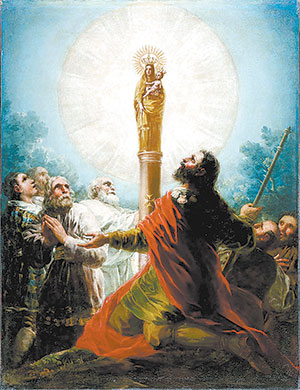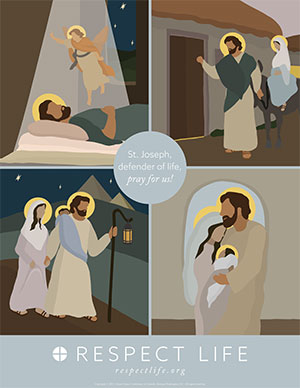Our Lady of the Pillar is patroness of Spain and all Hispanics
 Our Lady of the Pillar (officially in Spanish, “Nuestra Señora del Pilar de Zaragoza”) is recognized as the first Marian apparition in the history of Christianity and is the only one that happened while the Virgin Mary was still alive. Although it was technically a bilocation of Our Lady, because she was living with John the Apostle in Jerusalem, it is still regarded as an apparition by the tradition of the Church.
Our Lady of the Pillar (officially in Spanish, “Nuestra Señora del Pilar de Zaragoza”) is recognized as the first Marian apparition in the history of Christianity and is the only one that happened while the Virgin Mary was still alive. Although it was technically a bilocation of Our Lady, because she was living with John the Apostle in Jerusalem, it is still regarded as an apparition by the tradition of the Church.
According to tradition, James the Greater, brother of St. John the Evangelist, traveled with great effort to Roman Hispania (modern-day Spain) to evangelize the local tribes. He not only confronted great difficulties, but he also saw very little apostolic fruits of conversion. Tradition says that when he was at his lowest point of discouragement, in 40 A.D., while he was sitting by the banks of the Ebro River in Zaragoza (back then known as Caesaraugusta), Mary appeared to him accompanied by thousands of angels to console and encourage him.
The Virgin Mary, with the Child Jesus in her arms and standing on a pillar, asked St. James and his eight disciples to build a church on the site, promising that “it will stand from that moment until the end of time in order that God may work miracles and wonders through my intercession for all those who place themselves under my patronage.”
The church of Our Lady of the Pillar in Zaragoza is the first church dedicated to Mary in history, and it remains standing to this day, having survived invasions and wars.
During the Spanish Civil War (1936-1939), the Communists dropped three bombs on the church from an airplane. The bombs tore through the roof and hit the floor, but none of them exploded. The three now deactivated bombs are currently on display in one of the basilica’s walls.
Our Lady is also said to have given the small wooden statue of the apparition to St. James. It now stands on the pillar she arrived on. The wooden statue is a relatively simple image 15 inches high, standing on a jasper pillar 5.9 feet tall. But the crown adorning her head is a masterpiece. It was made in 44 days by 33 workmen. The sun-like crown is made of 2,836 diamonds cut triangularly, 2,725 roses, 145 pearls, 74 emeralds, 62 rubies and 46 sapphires. The crown of the baby Jesus is identical in shape, although not in size.
The basilica has been redesigned and expanded several times during its history. The current structure, completed in the 17th century, includes 11 brightly colored tiled domes and is the second biggest church in Spain.
Nuestra Señora del Pilar is not only the patroness of Spain but also of all Hispanic peoples, since it was on Oct. 12, 1492, the feast of Our Lady of the Pillar, that Christopher Columbus arrived on American land and the first Mass in the Americas was celebrated.
— Alejandro Bermudez, Catholic News Agency
October is Respect Life Month
Every October, we consider more deeply why every human life is valuable and reflect on how to build a culture that protects life from conception to natural death. The month is a time to celebrate Respect Life Month, and the first Sunday of October is designated as Respect Life Sunday.
This year’s celebrations focus on St. Joseph, defender of life.In a reflection from the U.S. bishops’ Secretariat of Pro-Life Activities, St. Joseph is noted as a perfect model for the Church’s pro-life work:“The infant Christ ‘came into our world in a state of great vulnerability. He needed to be defended, protected, cared for and raised by Joseph’ (“Patris corde,” 5). The humble and often hidden carpenter of Nazareth accompanied Mary in her pregnancy, assisted at the birth of the Messiah in a stable, presented Jesus in the Temple, fled with his family far from their homeland to protect them, and lovingly raised Jesus as his own son in the years to come.“While the angel of the Lord appeared to Mary to announce that she would bring forth the Savior of the world, it was revealed to Joseph in a series of dreams how God’s plans would be brought to fulfillment. As Pope Francis highlights, ‘God trusted Joseph, as did Mary, who found in him someone who would not only save her life, but would always provide for her and her child’ (“Patris corde,” 5).
“Like every other human family, the Holy Family had to confront real and concrete challenges. Yet, ‘in every situation, Joseph declared his own “fiat”’ (“Patris corde,” 3). His ‘yes’ to the Lord meant that regardless of the hardship and personal sacrifice to himself, he consistently chose to put the needs of Mary and Jesus before his own. Joseph’s devotion helps reveal to us our own call to show special care for the lives of those whom God has entrusted to us.
“During this Year of St. Joseph, each of us can find in him ‘an intercessor, a support and a guide in times of trouble’ (“Patris corde,” Intro). Joseph shows us how to say “yes” to life, despite our own fears, frailties and weaknesses. For it is Joseph who was ‘chosen by God to guide the beginnings of the history of redemption. He was the true ‘miracle’ by which God saves the child and His mother’ (“Patris corde,” 5).
“May we, too, be miracles in the lives of those who are most in need, especially at the beginning and end of life.
“Dear St. Joseph, you who were ‘able to turn a problem into a possibility by trusting always in divine providence’ (“Patris corde,” 5), help us to imitate your faithful trust and courage.”
Resources available online
At www.respectlife.org: Find prayers, ideas for getting involved, reflections and videos, and more information about the Church’s pro-life teachings and the celebration of Respect Life Month


